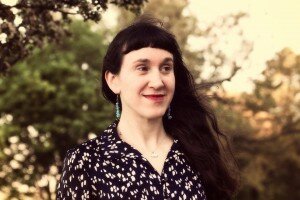In Kristy Bowen’s dream-like, three-part jewel, The Shared Properties of Water and Stars (, 2014), Bowen describes her own work as a “strange little fairy tale.” Broken up into three parts, the poems radiate a murky symbolism that is mysterious and sexualized, echoing and promising violence: women carry boxes of sadness, lace drags on the ground, sometimes the lace is blood-stained. Hundreds of bears lumber and low softly outside the windows.
There is also mystery — a forest, ghosts who carry tangerines. Elegant descriptions and short sentences propel the reader down a surreal, prose-poetic rabbit hole:
“There are three houses in three different colors. Each owner keeps a certain kind of sadness locked in the cupboard. The tall man lives in the white house. The short man keeps rabbits as pets…The woman in the second house keeps her sadness in a smallish box…The girl with the blonde hair lives next door to the man who keeps rabbits. One summer the rabbits multiply and chew through the fence.”
At this turn, the characters are nameless. There is a woman in a white dress, and a woman in a red dress who waits for “significant damage — to sprout feathers or scales.” These characters tease us with what we think we know — that everyone mostly “keeps to themselves” — but Bowen ultimately proves it is impossible for these subjects not to affect one another. The blonde girl goes from the innocent pastime of “ lining up her lipsticks on the coffee table” to cutting class and entering into a romantic relationship with the rabbit owner — referred to as the rabbit man — who has been watching her:
“In the basement, the rabbit man runs his tongue along the space between her fingers and thumb. It rains for days like this. The light is gray inside him (mostly air) (mostly fur).”
It is through the relationship between the blonde girl and the rabbit man that Bowen’s fairytale evolves, stretching the boundaries of the status quo. The rabbit man perhaps dreams of becoming a rabbit at night (or maybe he already is one? Bowen leaves this ambiguous). Such physical mutations serve a purpose in Bowen’s fairy tale: the characters manifest inner development through actual “outside” changes of body and environment.
“She guesses he dreams about moving quickly through the forest, past the edges of town and through the dark. Slight as his weight will carry him. She shivers and pulls the blanket closer while the bears outside fall, finally asleep.”
Bowen blends these themes of appearance and revelation through the text in other ways, including the presence of riddles. Reveals are like trap doors at the bottom of the lake Bowen describes in a dream. And dreams, too, are important for what they do and do not show us:
“In a dream, the woman in the white dress comes across a bear and a rabbit in the forest. Both of them furred, strange beings. The bear lies every Monday, Tuesday, and Wednesday and the other days he speaks the truth. The rabbit lies on Thursdays, Fridays, and Saturdays, however the other days of the week he speaks the truth.
Bear: Yesterday I was lying.
Rabbit: So was I.”
What is revealed and what is hidden can be fluent and mischievous, like waves, as are physical bodies and minds. We, Bowen’s readers, smoothly blend into our homes, our storage units, our pets.
By Part III, I was deeply entrenched in Bowen’s own songs of experience. All of the objects, characters, and symbols from the earlier two sections begin to intermingle. Boxes might be labeled with an “X,” or they are hidden in the garage and then forgotten. A kiss might hide a trail of blood. The bears roam through the houses at night and step over the beds of those who sleep.
“The woman in the red dress was young once, her skin and insides sweet as violets. The bears were only beginning to escape from their cages then, only beginning to devour her fingers and lumber over her bed each night when she was alone. Softer, she whispered when she felt their teeth. Softer.”
While the women, the bears, the ghosts, and the riddles play, it is the bear who comes more into focus towards the book’s end. He ushers endangered rabbits into the forest — that space where the domestic meets the feral — in hopes of saving them. The three parts of this collection combine so effortlessly, I read the words, envisioned circles in my head, not remembering where the blonde girl ends up and is the bear boy alone or safe on the last page? Like any beloved fairy tale, I re-read its words — and follow the lead of the blond girl:
“On good nights, the girl counts the stars on the roof and hides the telephone in the closet.”
is the author of three chapbooks: Every Her Dies (ELJ Publications), Clotheshorse (Finishing Line Press, forthcoming 2014), and Backyard Poems (Dancing Girl Press, forthcoming 2015.) Her work has been nominated for Best of the Net and has appeared in public places in Iowa City. Recent work can be seen / is forthcoming at Dressing Room Poetry Journal, Toad Suck Review, Red Savina Review, Toad: the Journal, The Poetry Storehouse, Quail Bell Magazine, Flapperhouse, and Hobart. She also writes for Insecurity Ragazine.


